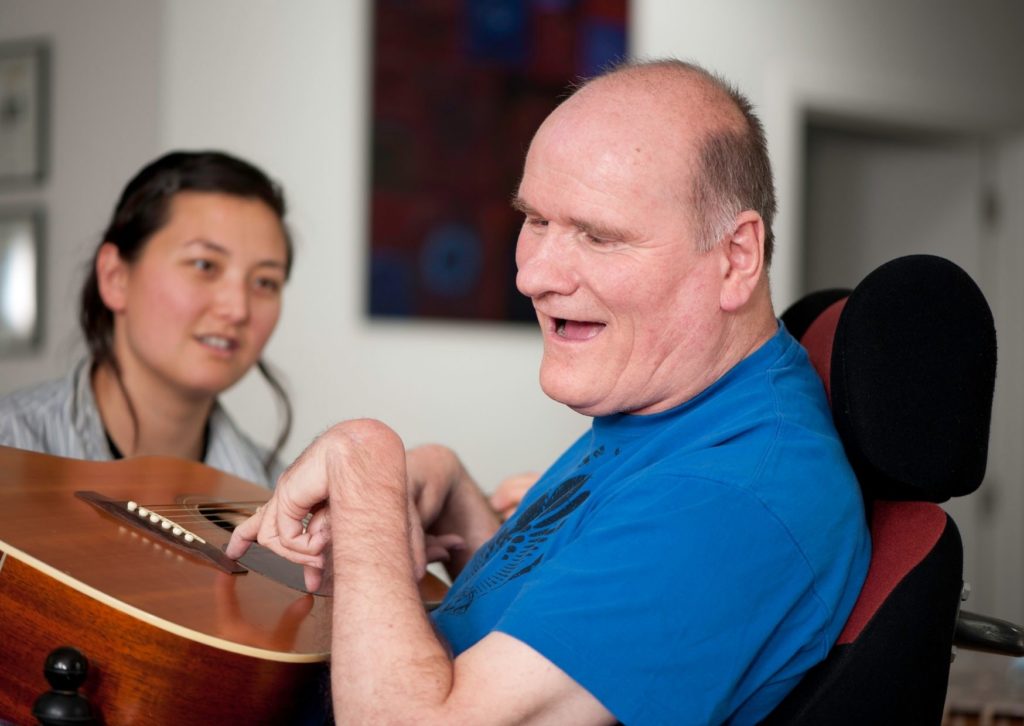For anyone who doesn’t use words, interacting through sound and gesture is immensely important in creating relationships and fostering a sense of agency. Through these interactions, that don’t depend on language, someone with PMLD can make choices: whether to communicate, who with, and how; can experience themselves acting in and on the world, can feel and hear themselves reflected back as their partner answers them.
Singing is a natural human activity – nearly everyone will admit to singing sometimes, even if only in private, in the shower, or the car and don’t be put off by the word ‘singing’: singing is simply breath made audible – it doesn’t have to be beautiful or tuneful. Singing promotes connection and integration: between voice and body [melody and rhythm], left and right sides of the brain [language and melody], and connects me to you and you to me: it connects what is inside us with the outside world. We don’t have to sing with words; ‘creature language’, otherwise known as nonsense or gibberish, is great fun to explore. People with PMLD, who may not have acquired language, may have a bigger palette and range of sounds than most of us as they may not have restricted themselves to the sounds that are used in our language and accepted by the prevailing culture. Everybody can sing: recently at a conference I heard the words ‘If you can breathe, you can sing’, and that’s my starting point.
At the very beginning of our lives, our survival depends on our relationships: our physical survival, but also the development of our sensory and nervous systems. Daniel Siegel, in his book ‘Mindsight’ says
‘We come into the world wired to make connections with one another, and the subsequent neural shaping of our brain, the very foundation of our sense of self, is built upon these intimate exchanges between the infant and her caregivers. In the early years this interpersonal regulation is essential for survival, but throughout our lives we continue to need such connections for a sense of vitality and wellbeing.’ [pp10-11]
Infants babble to make a connection with someone, or for the pure sensory pleasure of feeling mouth, tongue and lips vibrate, or to express feelings in a more nuanced way than a simple cry. People with PMLD have their own unique range of sounds and vocalisations: these sounds have pitch and rhythm, structure, pace and dynamics. Like music, they create a language of feeling, connection and sensation, a language of the heart.
One of his Siegel’s patients spoke of the importance of ‘feeling felt’ by another person, and he calls this ‘attuned communication’; a kind of ‘resonance’ with another person. It is striking that words used to describe connection with others are often borrowed from the world of sound and music: resonance, attunement, we think of being ‘in sync’ with another. When we sing we create vibrations, our bodies vibrate, and often when we sing together with others we can feel this attunement as a physical sensation.
Another name for this ‘syncing’ is entrainment, where rhythms begin to align with each other. Nina Kraus, who researches into music and the brain, has shown that our brainwaves follow the shape of the soundwaves that we hear, and it has been shown that people who sing together start to breathe together, and heart rates begin to co-ordinate.
In early development, gesture comes before sound, and then the two go together, part of what Daniel Stern calls ‘vitality forms’ – expressions of our essential vitality. Sound and gesture together can express and communicate the essence of ourselves; being heard and seen by another helps us to ‘feel felt’, and in turn strengthens our own sense of self. For anyone who doesn’t use words, interacting through sound and gesture is immensely important in creating relationships and fostering a sense of agency. Through these interactions, that don’t depend on language, someone with PMLD can make choices: whether to communicate, who with, and how; can experience themselves acting in and on the world, can feel and hear themselves reflected back as their partner answers them.
This connection with others helps us to feel safe in the world: early on, if we have responsive care-givers, his or her voice will help to soothe and calm us. Through exchanges of sound and gesture sometimes called ‘motherese’ we can tap into the nervous system of our carers and learn, eventually, to soothe ourselves. Humming and singing activate the vagus nerve, and the higher pitches, repetition and melodic compass typical of motherese create the conditions for us to feel safe, to feel seen, heard and felt. In vocal play we can open up the territory of the voice beyond motherese into an adventure playground where all sounds are welcome and can be enjoyed for their own sake.
Vocal play connects us more strongly to ourselves and to each other, and to the world around us: it can be fun to imitate the sounds of animals and the sounds we hear every day. Exploring sound in this way can help us to make sense of the world, to connect more deeply as part of the ever changing phenomena of the amazing natural and human created environment we find ourselves in.
Eleanor Gibson
References
Daniel Siegel, Mindsight, Oneworld publications, 2010
Nina Kraus https://www.youtube.com/watch?v=43I_PHyb_K
Daniel Stern – Forms of Vitality, OUP, 2010.
